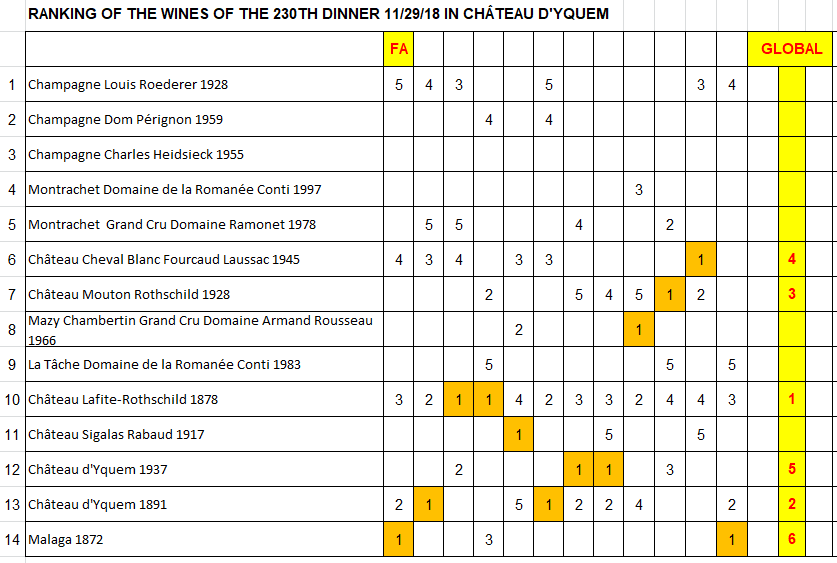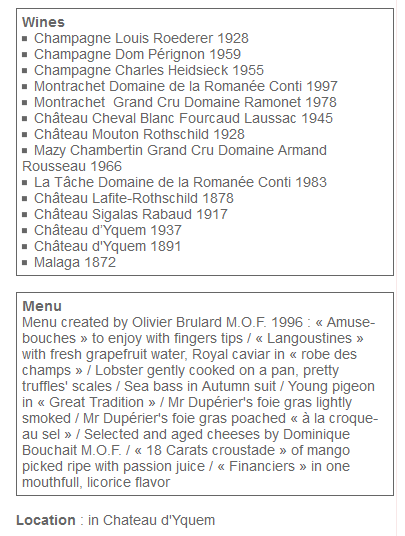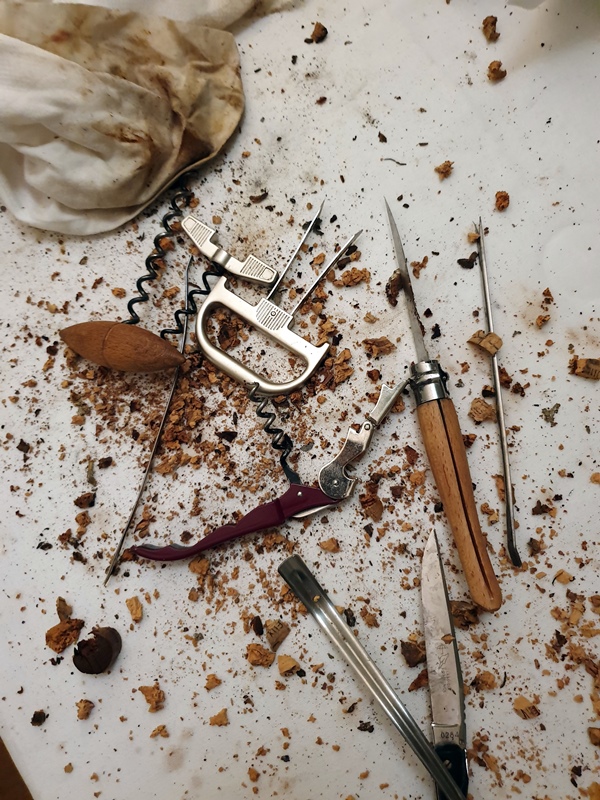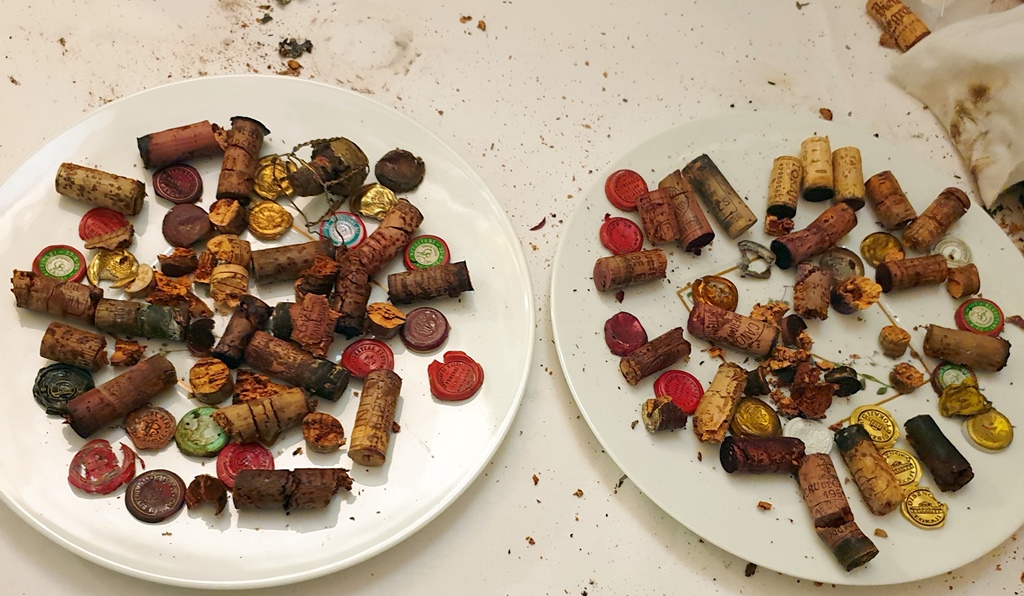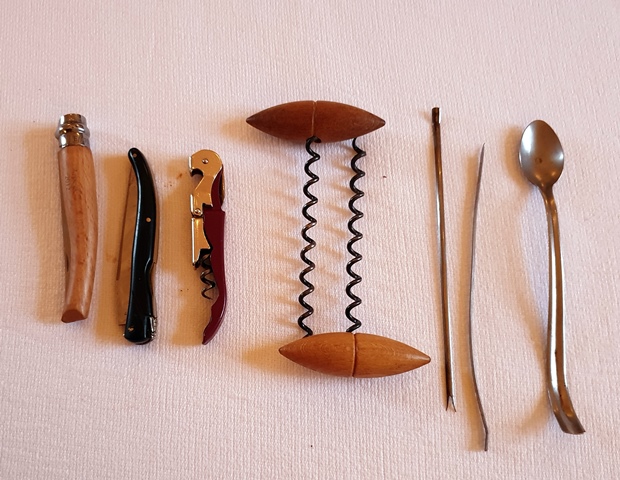(sorry, it is long, but it is one of my best ever memory)
The dinner will be held at the Château d’Yquem, with my wines. I came to deliver them two months ago and I worked to build the menu with the chef of the castle Olivier Brulard best worker of France (MOF) 1996 who worked during his career especially with Michel Guérard.
The day of the dinner, at noon we present ourselves to the castle. Valérie, the precious collaborator of the president of Yquem who assisted Alexandre de Lur Saluces and now Pierre Lurton will be present at the traditional lunch preceding my dinners in this place, while Sandrine Garbay and Francis Mayeur, the two who make Yquem and attended the previous lunches before my dinners will not be there, held back by other obligations. We will be four to test dinner dishes, two American friends, Valerie and me.
I brought a Maury of Vignerons de Maury 1929 which can accompany the dishes that we will test but will not serve as a witness, because it is very different wines that will be on the dishes tonight. The first dish that we try is the lobster cooked gently on the salt pan with pretty scales of truffles. The dish is delicious. The chervil in fine leaves refreshes well the dish as well as the leaves of chard but it is necessary to remove the heart of chard too abundant and bitter and to keep only tiny stamps of this vegetable. We drink a ‘Y’ Yquem 2016 very green and a little too dry, which will expand during the rest of the meal. The Maury is very suitable for lobster and creates a nice deal because this 16 ° wine has a lot of freshness. He has aged in demi-muids for more than sixty years which gave him a beautiful fluidity and a great delicacy. The dish will accompany two montrachets, one of the domain of Romanée Conti and one of Ramonet. Olivier agrees to make a smaller dish, more airy and less salty. We understand each other well.
We then try the foie gras. In the menu it is planned: Mr. Dupérier’s foie gras, lightly smoked and then poached, with salt and pepper. The plate includes foie gras in two ways, poached and smoked. It seems to me at once that the smoked will not be useful, because Lafite 1878 will not accept it. We must also remove the pine nuts planted in the livers. It turns out that Olivier who prepared the livers will not be able to put two slices of poached per person so the solution we adopt is that the smoked foie gras be served as a second course for the Burgundies, after the pigeon, and the foie gras poché will be as planned for the Lafite. We drink Chateau d’Yquem 2016, wonderful in its crazy youth because it has the candor and rosy cheeks of a baby. And that goes well with the livers. The Maury also finds its place with the non-smoked liver. The 2016 Yquem will be big, a Yquem cooler than powerful.
Usually in my dinners there is only one blue cheese for sauternes. But by dint of arguing with Olivier, we are going to have five blue cheeses: three English, stilton, stichelton, shropshire, and two French blues, the Régalis composition of Dominique Bouchait, a cheese MOF, and a fourme also of its composition. It is up to me to decide the order of service of these five cheeses which will be presented on individual plates what I do with good heart by checking that both the Yquem 2016 and the Maury 1929 feast on these cheeses. Stilton and Stichelton are my two favorite
The dessert is an 18-carat crunch of mango picked ripe with passion fruit juice. I have a little trouble with the lump of the crisp, the laminated breaks in the mouth, but as my lovely guests are accommodated, we will not touch this traditional recipe of Landes will be perfect for the three Sauternes of 1937 , 1917 and 1891.
We make the debriefing with Olivier Brulard. I change the size of the knives to cut the lobster, I exclude the breads for the plate of cheese, I determine the position of the glasses on table, because we will have fourteen glasses who will remain on the spot, I give the instructions of service of the wine compared to the dishes. Everything seems on track. This evening Olivier will be assisted by the Cheval Blanc chef to take advantage of this experience.
After a walk and a tiny nap, I’m ready for the opening of the wines. Valerie has reinforced the usual kitchen team of the castle and there will be a sommelier for the service of the wines, who assists in addition to my American friends at this ceremony. I open the wines in the order of service. The Domaine de la Romanée Conti 1997 Montrachet has a fragrance of rare generosity. He is fat and happy. The Montrachet Domaine Ramonet 1978 scares me. I dread a possible taste of cap, despite the fact that the cap does not smell cap. The sommelier does not smell anything. Hopefully everything is going well. The perfume of the Cheval Blanc 1945 is imperial and glorious. Phew! Because I would have been embarrassed if the wine that runs Pierre Lurton was not up to par.
The Mouton Rothschild 1928 has a scent that seems to me of rare delicacy. For now, that’s fine.
The Mazy Chambertin Armand Rousseau 1966 has a devilish scent. It is all the earthly and laborious Burgundy that explodes in my nostrils. Conversely, the La Tâche Domaine de la Romanée Conti 1983 has a noble and distinguished perfume while restraint. It was going well for Bordeaux, it goes well for Burgundy. As Laetitia, Napoleon’s mother, said, “let us hope that it will go on that way”.
The Lafite-Rothschild 1878 has a miraculous fragrance. The bottle was reconditioned at the castle in 1990. The wine has a very clear ruby color. The wine looks sweet. There too, I push a “phew” of satisfaction. The Sigalas Rabaud 1917 is a huge surprise because its perfume (I do not taste any wine, I feel it only) plays in the big leagues. It will match the thundering scent of Yquem 1937, which comes from Yquem’s cellar and has never moved, and with the fragrance of a confusing subtlety of Yquem 1891. And the last piece of cake, like Liz Taylor being Cleopatra, it is the unmistakable perfume of the Malaga 1872, concentrated with the fragrances of the Arabian Nights.
The opening operation lasted an hour and a half because I fought with many corks which did not want to go out. And I had a fright that gave me sweats, it is with the cap of the Yquem 1891 which, as soon as I cut the capsule went down in the neck and would have plunged in the liquid if I had not been able to grip it by manipulating it with extreme gentleness since every attempt to poke the cork made it go down.
Exhausted by these 90 minutes of permanent tension I go back to my room to prepare because the festivities begin in half an hour. Under my shower I have the smug smile of the idiot of the village, I am ‘Lou delighted’ because I know that my wines will be at the rendezvous.
The rendezvous of the dinner is at 6 pm in the oldest living room of the Château d’Yquem. We will be twelve at table, received by Pierre Lurton, president of Yquem and Cheval Blanc. Our assembly of eight men and four women is very cosmopolitan with three Americans from three different cities, Charlotte, Boston and San Francisco, a French living in New York, a French living in Singapore with his Japanese-born wife, two Chinese living in Oxford, an Italian, a German and me. Six participants were at some of my greatest dinners. Four guests participate for the first time. We introduce ourselves and Pierre Lurton joins us to welcome us. He makes us visit the cellars and quickly gives explanations on the botrytis, the harvest and the aging of Yquem.
We then go to the beautiful tasting room to taste three young Yquem. Their colors are very close and very clear, the 2001 being slightly more amber.
Pierre Lurton says he prefers the Château d’Yquem 2015 that we drink to the 2016. I agree with him for the future because the 2015 is powerful and rich. But for the immediate pleasure I prefer the 2016 drunk at lunch, more fluid, more delicate, while the 2015 is very marked by a strong sugar.
Château d’Yquem 2009 is a marvel of balance. He has everything for him. It evokes me gladly the 1893 which is probably the most balanced of all the Yquem. This 2009 is the joy of living.
The Château d’Yquem 2001 is a punch in my heart. This 2001 is a conquering Yquem warrior and in my imagination, while I never drank the 1847, the most famous Yquem with 1811, I imagine the 2001 is as big and legendary as the 1847. This Yquem has everything for him.
After this quick tasting commented by Pierre Lurton always so truculent, we go to the large antique lounge for aperitif. I opened all the wines but I did not open any champagne. So for me this is a big unknown, because if we start with a tired champagne, it can change the atmosphere of dinner. I pray the sky and the sommelier pours me the first glass of the Champagne Louis Roederer 1928. The color is almost pink. There is no bubble but in the mouth I feel the sparkling and, phew, the champagne is of exemplary purity. It is precise, does not have a gram of defect and its taste is charming, intense, deep. It is an immense champagne of 1928. It leaves in the mouth a strong trace made of beautiful red fruits.
Champagne Dom Pérignon 1959 is open and if the pschitt is weak, the bubble is more visible and the color is lighter. It’s obviously a big Dom Pérignon, vinous, active and present, but I admit that I have a soft spot for the more complex Louis Roederer. Small canapés are delicate.
We sit at the table in the very pretty dining room of the castle. The menu designed by Olivier Brulard, chef of the castle and developed with me is: appetizers to enjoy with fingertips / langoustines “blue” with fresh water grapefruit, Royal caviar in dress field / cooked lobster gently in the saltire, pretty scales of truffles first / line bar in autumn coat / squab “Great Tradition” / foie gras M. Dupérier slightly smoked / poached foie gras, with croque-au-sel / selected cheeses and refined by Dominique Bouchait MOF / Crisp “18 Carats” of mango picked ripe with passion / financial juice from a mouthful of licorice.
The Champagne Charles Heidsieck 1955 is like the two previous ones of a purity and a remarkable precision. My guests wonder how it is possible to have three champagnes as old, so at risk, which are so perfect. The 1955 is racy, long, with a strong personality that will find with the lobster and grapefruit water jelly an agreement that is probably the best of the meal with the one that we will have on a poached foie gras. The presentation of the dish is of a remarkable aesthetic. The champagne vibrates with the flesh of the langoustine served fresh but even more with the water of grapefruit. And the end point is given by the caviar highlighted by a sweet potato that gives a boost to the champagne. Of the three champagnes, it is the Dom Pérignon which made its age that is to say a beautiful maturity, while the other two because of their intensity have no age.
On lobster we have two montrachets. The Montrachet Domaine de la Romanée Conti 1997 has the glorious nose of the estate’s Montrachet. Theoretically it is not a very powerful year, but in practice it is flamboyant and very broad. He is not as fat as others who are more powerful, but he is joyfully thick and intense.
The Montrachet Grand Cru Domaine Ramonet 1978 is very different. First of all, he does not have the slightest trace of a cork that I feared. I was scared for nothing. If the 1997 is an extreme width, giving a joyful mouth, the 1978 is all in depth and refinement. To prefer one or the other is not easy. The Italian friend prefers the Ramonet which is of an ideal presentation and has no age. The Ramonet is very racy, the Conti is very gourmand. I would say that for the perfect lobster and generously truffled, it is the 1997 Conti that is the most rewarding. But the nobility of Ramonet is extreme.
The mushroom line bar (sea bass) is accompanied by two great Bordeaux and many guests will admire the relevance of an agreement they would not have imagined. Château Cheval Blanc Fourcaud Laussac 1945 has a truffle nose of extreme power and on the palate, it is generous, powerful, concentrated, square, glorious and so good that one would be ready to place it over the most legendary 1947 Cheval Blanc which more more atypical. This truffled wine is a splendor and I am happy to have put it in the presence of the one who runs the Cheval Blanc castle. The wine has such a balance that it seems indestructible and built for eternity.
Beside him, the Château Mouton Rothschild 1928 is an exceptional Mouton, full of charm and enigmas. He is elusive. I am totally under his spell. The Cheval Blanc is masculine, solid warrior while the Mouton is feminine, all in charm. And what’s good is that the two wines do not harm each other, on the contrary, we go from one to the other by developing our pleasure. We drink two huge wines and I did not expect Mouton 1928 to be so complex and brilliant.
The pigeon accompanies two Burgundy wines, and here again, as for the Montrachets and the Bordeaux wines, two very different wines. The Mazy Chambertin Grand Cru Domaine Armand Rousseau 1966 has a diabolical nose to wake the dead. This is the affirmation of Burgundy the most earthly, hardworking, feet in the clay. It is a Burgundy that takes the guts and in the mouth we have a wine of pleasure, nature, diabolically attractive.
Beside, La Tâche Domaine de la Romanée Conti 1983 is carrying the subtlety of the domaine of Romanée Conti. We are in elegance. The pigeon speaks a lot more with Mazy Chambertin. While the smoked foie gras that is served after converse elegantly with La Tâche. I have a soft spot for the most ‘commoner’ of the two.
Château Lafite-Rothschild 1878 is like the 1955 Charles Heidsieck alone on a dish, on poached foie gras. This wine was reconditioned at the château in 1990 with the marks attesting to this operation. The wine has a beautiful color very young. The nose is intense. It is incredible finesse, nobility and accomplishment. It seems so natural. I spoke discreetly with Pierre Lurton, who agrees with me, the age feels with a slightly meaty taste probably latent and arisen during refilling, which signs the authenticity of the wine and does not harm the pleasure to the point that this wine will be the only one to appear on the twelve voting sheets, devoting its first place to the wines of the meal. The accord with the foie gras is magical and the sweetness highlights all the subtleties of the wine. We had at a previous dinner a superb Lafite 1898. This one is at least the same level, maybe a little more romantic and delicate. It is a 140 year old anthology.
At this stage we wonder how we will be able to prioritize wines as different and all perfect. It is now the moment of the three Sauternes served at the same time. From left to right we have Château Sigalas Rabaud 1917, Château d’Yquem 1937, Château d’Yquem 1891. The colors of the two extremes are almost identical, of a very dark mahogany, and the 1937 is amber but lighter than the two others. These three wines will have two services, the five cheeses then the dessert.
The Château Sigalas Rabaud 1917 is a huge surprise because it is at the top of the elite tastes of Sauternes. It is deep, rich, with notes of caramel or candied banana, but it is especially his race that is beautiful. He will be voted once as first and he deserves it.
The Château d’Yquem 1937 is a conquering warrior. It’s the glorious, juicy, happy Yquem, it’s Marlon Brando in his youth. Because this Yquem is very young, and will live many decades more.
The Château d’Yquem 1891 is of infinite complexity. I fall under his spell because he is so subtle, evocative, intriguing. His journey in the mouth is multifaceted. He has the charm, the seduction then the enigma, the subtlety, the same plot. We never go around. I am fascinated by its complexity because it is not a powerful Yquem, it is a Yquem of meditation. The cheeses have done well with the three sauternes and the agreement with the mango dessert is so natural that we enjoy it without question, because it’s perfect.
Now come the judicious financiers cakes on Malaga 1872 whose handwritten label bears only these mentions. I swoon. Because its exotic, unreal flavors are unimaginable. We are transported to a planet of lust. Everything is powerful but so delicate. The length is infinite. We are in paradise. And what makes it magical is that there are totally unfamiliar tastes.
Joe, a faithful friend present at Veuve Clicquot dinner and at the 200th dinner, tells me that never in his life did he have a dinner of this quality. He is thrilled and I admit that I did not expect that all the wines of the dinner cannot be the object of any criticism. They are at the top of what they can bring. How to vote in these conditions, many tell me but it is the rule to vote.
We are twelve to vote for the five favorite wines on fourteen wines. Thirteen wines appear in the votes which confirms the excellence of all. If the Charles Heidsieck is not in the votes it is not because of its quality which is extreme, it is that at the end of the meal, the memory fades on the wines of the beginning.
What delights me even more is that eight wines were deemed worthy of being first. Unbelievable ! Four wines were judged first twice and four wines were judged first once. The doubles first are: Lafite 1878, Yquem 1937, Yquem 1891 and Malaga 1872. The four first-time votes are: Cheval Blanc 1945, Mouton 1928, Mazy Chambertin 1966 and Sigalas Rabaud 1917. Sometimes people say that I influence the votes. If eight wines are named first, my influence is very small.
The consensus ranking would be: 1 - Château Lafite-Rothschild 1878, 2 - Château d’Yquem 1891, 3 - Château Mouton Rothschild 1928, 4 - Château Cheval Blanc 1945, 5 - Château d’Yquem 1937, 6 - Malaga 1872.
My classification is: 1 - Malaga 1872, 2 - Château d’Yquem 1891, 3 - Château Lafite-Rothschild 1878, 4 - Château Cheval Blanc Fourcaud Laussac 1945, 5 - Champagne Louis Roederer 1928.
In a dinner where there are two excellent wines from the Domaine of Romanée Conti, note that neither of the two is among the top six, this indicates the level of others. One reason is that we have crowned the very old wines since the average age of the six classified wines is 110 years old. This explains that.
What about this dinner otherwise than everything was perfect. The wines made a no-fault that impressed the guests. Food and wine pairings, even daring, were perfect. The place where the dinner was held is magical and Pierre Lurton welcomed us with friendship. It’s probably one of the three best dinners I’ve had, if not the biggest one. The atmosphere of friendship that has developed between the guests makes it a rare dinner.
